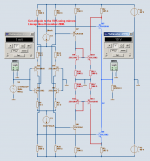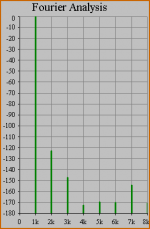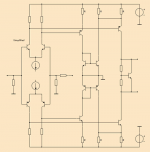This is an idea I got today.
And the sim tests shows very good results.
When we use 4 input transistors in Complementary LTP configuration
we want to utilize the input gain as much as possible.
There are many ways to do this.
But not many ways take full advantage of full gain of both pairs.
This idea uses a mirror part to add the gain from the inverted input.
See red part in my circuit.
The output of resulting gain is taken from collectors of the blue output (VAS).
In this circuit I use the very good 2SC2362/2SA1016. Excellent transistors that can take high voltage.
All transistors in my schematic works at 5 mA current.
Lineup
And the sim tests shows very good results.
When we use 4 input transistors in Complementary LTP configuration
we want to utilize the input gain as much as possible.
There are many ways to do this.
But not many ways take full advantage of full gain of both pairs.
This idea uses a mirror part to add the gain from the inverted input.
See red part in my circuit.
The output of resulting gain is taken from collectors of the blue output (VAS).
In this circuit I use the very good 2SC2362/2SA1016. Excellent transistors that can take high voltage.
All transistors in my schematic works at 5 mA current.
Lineup
Attachments
Hi Lineup,
The gain of your circuit is determined ultimately by your load resistor R6, which can be made arbitrarily large in a simulator. But once you start to drive a real impedance, you will most probably see that the gain collapses and that - without feedback - the distortion rises if you drive a (non-linear) Vas input R.
Your circuit is interesting and neat, but very often reality smashes dreams....
Jan Didden
The gain of your circuit is determined ultimately by your load resistor R6, which can be made arbitrarily large in a simulator. But once you start to drive a real impedance, you will most probably see that the gain collapses and that - without feedback - the distortion rises if you drive a (non-linear) Vas input R.
Your circuit is interesting and neat, but very often reality smashes dreams....
Jan Didden
Hi Lineup,
mount a complementary feedback pair on U5 and U6 and for most real loads it will be essentially load invariant.
You might also use the Lender VAS drive, base to one side of the LTP and emitter to the other, with suitably amended load resistors to keep it balanced, and you can eliminate the four transistors in the current mirror. This will have much less phase shift.
Hugh
mount a complementary feedback pair on U5 and U6 and for most real loads it will be essentially load invariant.
You might also use the Lender VAS drive, base to one side of the LTP and emitter to the other, with suitably amended load resistors to keep it balanced, and you can eliminate the four transistors in the current mirror. This will have much less phase shift.
Hugh
lineup,
Karma came around and bit you in the ***...
I would go for a less messed up VAS. Also, high open-loop gain does not lead to Nirvana, which should be considered established beyond the shadow of a doubt, after decades of heroically insistent experiments.
Karma came around and bit you in the ***...
I would go for a less messed up VAS. Also, high open-loop gain does not lead to Nirvana, which should be considered established beyond the shadow of a doubt, after decades of heroically insistent experiments.
- Status
- Not open for further replies.
- Home
- Amplifiers
- Solid State
- Complementary Input Gain = 10000 !!!


